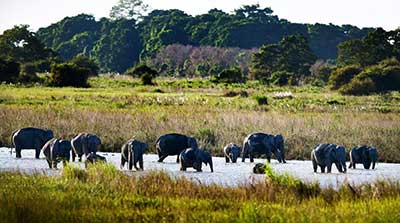Date: 02/01/2023
Relevance: GS-3: Environment, Biodiversity and its Conservation; International Conventions.
Key Phrases: Biodiversity Conservation, Convention on Biological Diversity (CBD), COP(Conference of Parties), Global Biodiversity Framework, Developed Countries, Conservation Efforts, Credibility, UNEP.
Context:
- At the 15th Conference of Parties (COP15) of the Convention on Biological Diversity (CBD), member countries adopted the “Kunming-Montreal Global Biodiversity Framework” (GBF) that includes 4 goals and 23 targets to be achieved by 2030.
Key Highlights:
- Although the adopted Global Biodiversity Framework is not legally binding, countries will have to demonstrate progress towards achieving the framework’s goals through national and global reviews.
What is Target 3 of the Global Biodiversity Framework (GBF)?
- Target 3 of the new biodiversity framework represents significant commitment as it would require cooperation at a global level
- Among the 23 targets, Target 3, colloquially known as “30×30”, requires that “at least 30 percent of terrestrial, inland water, and coastal and marine areas, especially areas of particular importance for biodiversity and ecosystem functions and services, are effectively conserved and managed through ecologically representative, well-connected and equitably governed systems of protected areas and other effective area-based conservation measures.
- Place-based conservation has usually taken the form of “Protected
Areas” wherein human occupation or at least the exploitation of
resources is limited.
15th Conference of Parties (COP15) of CBD - Convened under UN auspices, chaired by China, and hosted by Canada, the 15th Conference of Parties to the UN Convention on Biological Diversity adopted the “Kunming-Montreal Global Biodiversity Framework” (GBF), including 4 goals and 23 targets for achievement by 2030.
- It was held at Montreal's Palais des Congrès Dec. 7-19, representatives of 188 governments on site (95% of all 196 Parties to the UN CBD, as well as two non-Parties – the United States and The Vatican).
- It finalized and approved measures to arrest the ongoing loss of terrestrial and marine biodiversity and set humanity in the direction of a sustainable relationship with nature, with clear indicators to measure progress.
- COP15 delegates agreed to establish within the GBF a multilateral fund for the equitable sharing of benefits between providers and users of DSI, to be finalized at COP16 in Türkiye in 2024.
- The agreement also obligates countries to monitor and report every five years or less on a large set of "headlines" and other indicators related to progress against the GBF's goals and targets.
- Headline indicators include the percent of land and seas effectively conserved, the number of companies disclosing their impacts and dependencies on biodiversity,and many others.
What are the Major Challenges?
- One of the main challenges will be to improve the quality of both existing and new areas, as biodiversity continues to decline, even within many Protected Areas.
- Demographically large, high population density countries, and the very high density small and city-states are unlikely to be able to bring significant additional terrestrial, inland water, and coastal and marine areas under Protected Area management.
- Moreover, species range shifts due to the effects of impacts of climate change will have to be taken into account.
- Challenges faced by Protected Areas that are experiencing coastal squeeze due to rising sea level on one side, and hard human settlements on the other will also have to be addressed.
- The track record of the Global North, thus far, has been poor in meeting its commitments on financial support for climate and biodiversity initiatives.
Way Forward:
- Innovative area-based conservation measures will have to be considered
for better connectivity for movement of species – megafauna in particular
– between protected and conserved areas.
- Protected and conserved areas will need to be better connected to each other for movement of species, and for ecological processes to function.
- Crop in the identified adjoining area is needed compulsorily insured
against wildlife damage by the state as part of the protection measure.
- This will minimize the human-animal conflicts and help to ensure better animal friendly culture.
- The additional expenditure by the state in developing countries on
account of insurance and verification post depredation could be met from
the expected financial flows from developed countries of at least US$ 20
billion per year by 2025, and US$ 30 billion per year by 2030.
- For this purpose, a trust fund under the Global Environment Facility is expected to be established in 2023.
- Conservation Development Mechanism, akin to the Clean Development
Mechanism under the climate convention, can be established.
- Under this, the economically strong countries can invest in biodiversity conservation projects in the economically weak countries.
- Innovative management will be required for Protected Areas that are experiencing coastal squeeze due to rising sea level on one side, and hard human settlements on the other.
- In high altitude and coastal areas, Protected Areas will have to be
conceived as mobile rather than static, confined to a set of geographical
coordinates.
- Issues that are not considered part of conservation measures will have to be included within the ambit of conservation.
- If the persistence of certain species and their habitats are considered critical, range shifts will have to be accounted for and spaces that are not currently within Protected Area management will have to be secured ex-ante.
- Competing claims over such spaces will have to be negotiated and resolved as part of the conservation effort.
Conclusion:
- Adopting the “Global Biodiversity Framework” is only a milestone, not a destination, and there is a long and arduous journey ahead.
- This is an opportunity to further strengthen international cooperation and solidarity whilst delivering justice and protecting biodiversity.
Source: ORFOnline
Mains Question:
What is the Global Biodiversity Framework? Discuss associated challenges and suggest measures to address these issues. (150 Words)









